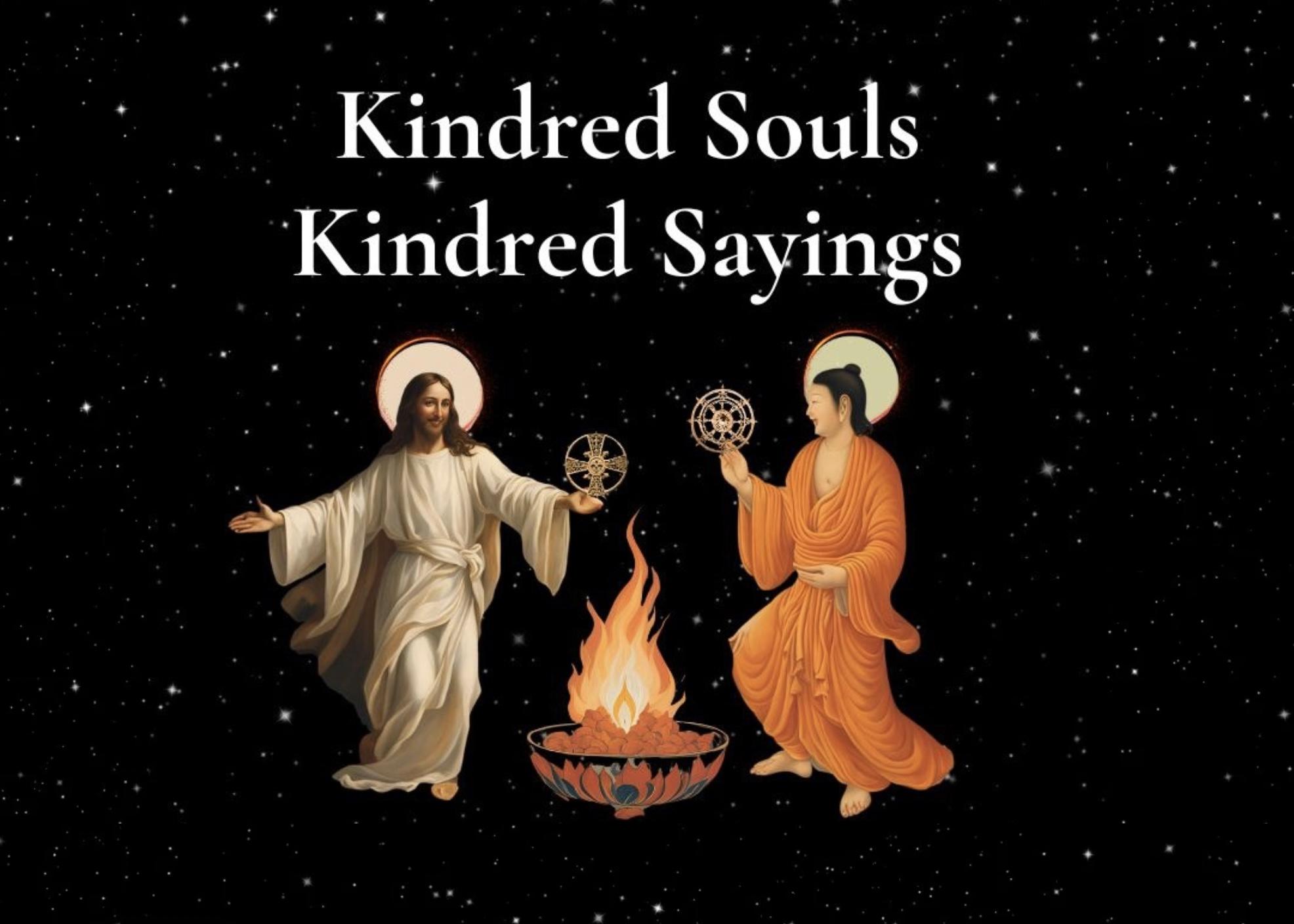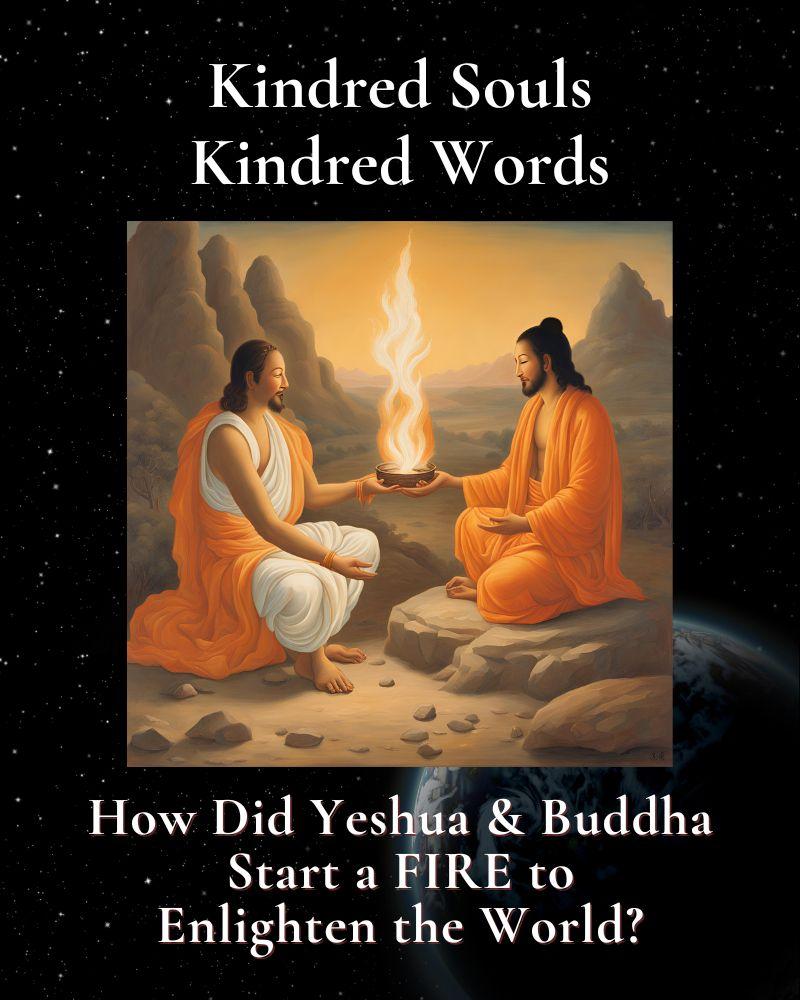
They Said They Came to Light a Fire to Change the Destiny of Humanity. How Did They Ignite the Fire?
![]()
Both Masters used metaphors of fire and light to describe their mission and its lasting impact.
When Jesus spoke again to the people, he said, “I am the light of the world. Whoever follows me will never walk in darkness, but will have the light of life.” Yeshua
John 8:12, New International Version
“I am the light of the world. I spread the light of knowledge wisdom; I conquer the darkness of ignorance. I hold the torch; I am the bright light.” Buddha
Tibetan Kangyur, ༄༅། །ཤེས་ཕྱིན་ཁྲི་པ། །
Dasasahasrikaprajñaparamita 26.234
![]()
Jesus said, “I’ve cast fire on the world, and look, I’m watching over it until it blazes.” Yeshua
Gospel of Thomas, Saying 10, tr. Mark M. Mattison
Jesus saith, “Many of you think that I have come to establish peace upon the earth. I will not bring peace, but dissension, fire, sword, and war. Families will be divided because of me, friends shall cease from one another, nations shall join in battle. Yea, those who would follow me must be willing to forsake all and to stand alone if they would inherit the kingdom of my Father.” Yeshua
Gospel of Thomas, Saying 8
The Lost Books of The Bible
https://thelostbooks.org/the-sayings-of-jesus/
Jesus said, “He who is near me is near the fire, and he who is far from me is far from the kingdom.”
Gospel of Thomas Saying 82, tr. Mark M. Mattison
John 10:10, The Message Bible
“There is a light within a man of light, and it gives light to the whole world. If it does not give light, there is darkness.” Yeshua
Gospel of Thomas, Saying 24
“The truth is the light that enlightens all who come into the world.” Yeshua
Nag Hammadi, Gospel of Truth
“You are the light of the world. A city set on a hill cannot be hidden. Nor do people light a lamp and put it under a basket, but on a stand, and it gives light to all in the house.”
Matthew 5:14-16
John answered and said to them all, “As for me, I baptize you with water; but One is coming who is mightier than I, and I am not fit to untie the thong of His sandals; He will baptize you with the Holy Spirit and fire.”
Luke 3:16, New American Standard Bible
Matthew 3:12-13, New Century Version
![]()
How did the Buddha “Turn the Wheel of Dharma”, to Change our Destiny Path Forever?
Ancient legends in India foretold that a great Raja or King would conquer the world, and he would be called the “The Wheel-Turning King” (Rajacakkavattin) and he would be unconquerable. His power to alter human destiny is symbolically expressed by the Wheel (Cakka) which once turned, can never be turned back. The Cakka was a wheel-like weapon used in wars in ancient India. The Dharma Wheel is a metaphor for the teachings or sacred path of Buddhism. The Buddha taught people how to re-train body, mind, and spirit to harmonize with the great trichiliocosm, meaning the vast multiverse of infinite realms, interconnectedness, and perfection in Buddhism.
After the Buddha “Turned the Wheel of Destiny”, all the wrong thinking and evil actions would vanish, and all beings would be able to achieve perfect ascension to Nirvana.
At that time the Blessed One spoke these verses:
- “The wheel of Dharma has been turned,
- Which is profound, hard to behold, and subtle.
- It is not understood by the extremists,
- Nor by the demons.
26.219 - “The wheel of Dharma has been turned,
- Which is without an all-ground and beyond concepts, [F.212.b]
- Unborn and without origination,
- Unique and empty of inherent nature.
26.220 - “The Buddha has turned the wheel
- That teaches the Dharma of equality,
- Without anything to accept and reject,
- Causeless and without characteristics.
26.221 - “The Protector of the World
- Has turned the wheel that is like
- An illusion, a mirage,
- A dream, an echo, or a moon reflected in water.
26.222 - “It leads beyond conditioned phenomena;
- It is not nihilistic and neither is it permanent,
- But cuts through all views—
- So is the wheel of Dharma described.
26.223 - “It is an infinitely vast teaching,
- Ever equal to space,
- Luminous and nonconceptual—
- So is the wheel of Dharma described.
26.224 - “It is free from existence and nonexistence,
- Beyond self and no self,
- A teaching that is naturally unborn—
- That is what we call the wheel of Dharma.
English translation from Tibetan by the Dharmachakra Translation Committee under the supervision of Chökyi Nyima Rinpoche, under the patronage and supervision of 84000: Translating the Words of the Buddha, https://84000.co/translation/toh95#UT22084-046-001-chapter-26
Chapter 26, TURNING THE WHEEL OF DHARMA, The Play in Full (Lalitavistara), རྒྱ་ཆེར་རོལ་པ།, The Play in Full, འཕགས་པ་རྒྱ་ཆེར་རོལ་པ་ཞེས་བྱ་བ་ཐེག་པ་ཆེན་པོའི་མདོ།
![]()
The Fire Sermon
I have heard that on one occasion the Blessed One was staying in Gaya, at Gaya Head, with 1,000 monks. There he addressed the monks:
“Monks, the All is aflame. What All is aflame? The eye is aflame. Forms are aflame. Consciousness at the eye is aflame. Contact at the eye is aflame. And whatever there is that arises in dependence on contact at the eye — experienced as pleasure, pain or neither-pleasure-nor-pain — that too is aflame. Aflame with what? Aflame with the fire of passion, the fire of aversion, the fire of delusion. Aflame, I tell you, with birth, aging & death, with sorrows, lamentations, pains, distresses, & despairs.
“The ear is aflame. Sounds are aflame…
“The nose is aflame. Aromas are aflame…
“The tongue is aflame. Flavors are aflame…
“The body is aflame. Tactile sensations are aflame…
“The intellect is aflame. Ideas are aflame. Consciousness at the intellect is aflame. Contact at the intellect is aflame. And whatever there is that arises in dependence on contact at the intellect — experienced as pleasure, pain or neither-pleasure-nor-pain — that too is aflame. Aflame with what? Aflame with the fire of passion, the fire of aversion, the fire of delusion. Aflame, I say, with birth, aging & death, with sorrows, lamentations, pains, distresses, & despairs.
“Seeing thus, the well-instructed disciple of the noble ones grows disenchanted with the eye, disenchanted with forms, disenchanted with consciousness at the eye, disenchanted with contact at the eye. And whatever there is that arises in dependence on contact at the eye, experienced as pleasure, pain or neither-pleasure-nor-pain: With that, too, he grows disenchanted.
“He grows disenchanted with the ear…
“He grows disenchanted with the nose…
“He grows disenchanted with the tongue…
“He grows disenchanted with the body…
“He grows disenchanted with the intellect, disenchanted with ideas, disenchanted with consciousness at the intellect, disenchanted with contact at the intellect. And whatever there is that arises in dependence on contact at the intellect, experienced as pleasure, pain or neither-pleasure-nor-pain: He grows disenchanted with that too. Disenchanted, he becomes dispassionate. Through dispassion, he is fully released. With full release, there is the knowledge, ‘Fully released.’ He discerns that ‘Birth is ended, the holy life fulfilled, the task done. There is nothing further for this world.'”
SN 35.28, PTS: S iv 19 , CDB ii 1143, Adittapariyaya Sutta: The Fire Sermon
Translated from the Pali by Thanissaro Bhikkhu, https://www.accesstoinsight.org/tipitaka/sn/sn35/sn35.028.than.html
Meaning:
When you are no longer fascinated with the physical world, when you no longer cling to it, this is the end of death and rebirth. i.e. Enlightenment.
– **Adittapariyaya Sutta (SN 35.28)**: (https://www.accesstoinsight.org/tipitaka/sn/sn35/sn35.028.than.html)



